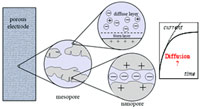Publication
892
ACS Appl. Energy Mater., 2 (7), 4981-4986, 2019
DOI:10.1021/acsami.9b05240
|
|
|
|
|
|

|
Electrochemical Capacitive Charging in Porous Materials. Discriminating between Ohmic Potential Drop and Counterion Diffusion |
|
|
|
Cyrille Costentin, and Jean-Michel Savéant
Université Paris Diderot, Sorbonne Paris Cité, Laboratoire d'Electrochimie Moléculaire, Unité Mixte de Recherche Université – CNRS N° 7591, Bâtiment Lavoisier, 15 Rue Jean de Baïf, 75205, Paris Cedex 13, France
Capacitors and batteries are the two main electrochemical means to store electrical energy. In the first case, good performances in terms of capacitance are closely related to the porous structure of the electrode coating material. Remarkable performances in terms of capacitance are indeed achieved by the increase of the area of the interface between the electronic conducting material of the film and the ionic solution in the pores. With respect to the dynamics of charge storage, we show that it is not governed by counterion diffusion as often asserted. It is rather related to ohmic potential drop in the pores. This is demonstrated first in the case of a simple planar electrode and then generalized to the case of porous films. A quantitative treatment is further described based on a transmission-line approach of the problem, after careful distinction between nanopores (of the size of compact double layers) and mesopores. Application to available experiments show remarkable agreement between theoretical predictions and experimental data. It is finally emphasized that the distinction between nanopores and mesopores entails two different metrics as far as energy storage and power are concerned. |

